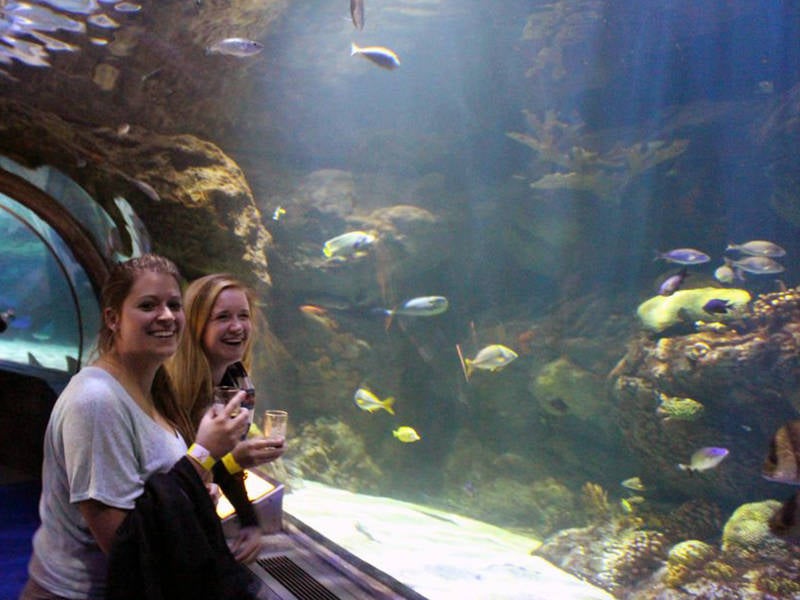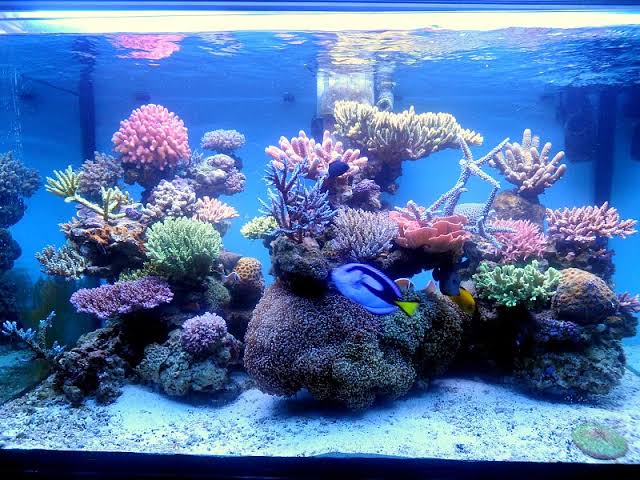
Description of this model of aquarium:
I intend to share all the Know-How, (Fundamental Knowledge), related to the type of aquarium in which I have worked in recent years. The type of aquarium that I propose to detail as a recipe is quite specific:
Community freshwater aquarium, well planted, very well balanced, with fish and tropical plants, generally small, among which I must highlight the Guppy. I use a soft water, with neutral PH, and temperature of about 24.5 degrees. For the bottom I use quartzite substrate.
The choice of tropical plants and fish can be made within an enormous variety and availability in shops, and the choice of soft and neutral fresh water is because in Madrid drinking water domestic supply has these characteristics and I avoid the work of water conditioning.
There are many types of interesting aquariums, but this one that I am going to propose, is especially interesting at the time of sharing the hobby with more people, since the fish and plants that are suitable for him, are authentic classics of the aquariofilia and do not offer difficulties nor great problems to the novice amateurs.
Physical-chemical conditions of water:
- Temperature: From 24.5 to 27 degrees centigrade (the low temperature, within the margin of tolerance, makes the fish live longer).
- PH: from 6.5 to 7.5
- Hardness: Soft water.
General characteristics for the fish in this aquarium:
The size of the fish:
I’ve had big fish for a long time, beautiful disc fish. They are spectacular and I managed to raise them in my aquarium. These fish need to raise 29 degrees Celsius and the plants tend to grow worse at such high temperatures. Little by little I have been interested in smaller fish that allow me greater variability and play with population balances, which is a subject that interests me very much.
An important difference in fish size is always a source of problems. This is true even when we have a selection of highly compatible fish. Even large, peaceful fish will claim their space when it comes to sharing food with the little ones.
No matter how big an aquarium is, it is still a very limited space. In a community aquarium the choice of large and majestic fish would limit us to a few specimens. Having a few specimens in an aquarium does not fulfil one of the objectives I have set myself for this type of aquarium, which is none other than to make the aquarium a perfectly balanced small ecosystem.
A few large fish do not lend themselves to talking about an ecosystem with a balanced population balance. Large fish are often condemned to live in very limited populations (few individuals and little space for them).
For our aquarium we have to be very careful not to choose aggressive fish with other fish and that these are respectful with the plants. I am going to suggest some species as a guide, but we must avoid the temptation to maintain an excessive variety of species or to maintain a high number of individuals so that the aquarium functions as a miniecosystem.
The guppy:
A fish that interests me especially for this aquarium is the Guppy for giving birth to fry that, even newborns, are able to survive in a well planted aquarium. Getting the Guppy population to self-maintain spontaneously in a community aquarium is a challenge.
In this aquarium we must respect some areas scattered throughout the aquarium, with plenty of plants that grow abundantly near the surface providing a mesh of hiding places for the fry of guppis to take refuge. A plant especially interesting for this purpose is the Rotala rotundifolia.
On a certain occasion I looked with a magnifying glass at a Rotala rotundifolia leaf that was stuck to the glass with the typical bacterial fabric that usually grows in infusorial cultures and I could appreciate that it was full of them. For this reason, they not only carry out the task of hiding, but also that of providing food for the fry so that they can prosper.
Even so, the fry will go through a first stage of growth very complicated by competition with fish much larger than them from which they must hide continuously. If you have room to fatten them in a separate aquarium, many more will survive.

If you don’t do it because of lack of time, space or desire, not all fry will survive the critical phase of the first few weeks. Thanks to this they will become an important food link in the aquarium that will connect the microfauna of the aquarium with the macrofauna.
The fry consume a series of infusories and small foods that would otherwise end up in the filter or substrate. I have the guppies in my aquarium to perform this function and I avoid having large fish that prey on the surface of the aquarium so that a good part of the offspring can survive.
For example, I avoid having guramis. I preferably choose fish that in adult state measure from head to tail beginning between 4 to 6 centimeters. Those that are a little bigger than that size, I try that they are very peaceful fish and that they prefer to swim from the middle of the aquarium down where the fry of the Guppys do not usually prowl.
The fish species you mention here are for guidance only. There are many more fish that can be used for this aquarium, but I must also warn that a single wrong fish can cause a disaster in an aquarium of this type where biological balance is the main objective. Coexistence between different species is particularly important with small fish.
Very conflictive fish in this type of aquarium:
- Pterophyllum scalare (Escalar, Angelfish): They are very pretty when they are small, but when they grow they attack the smallest fish. They can swallow an entire neon or they can gouge out the eyes of other fish.
- Cyclids from large African lakes: they are aggressive fish and do not respect plants. They need hard, alkaline water.
- Synodontis (inverted catfish): At night they devour plants.
Recommendable fish that deserve a special comment:
(Guppy): Viviparous, peaceful fish that can reproduce spontaneously in the aquarium. It will play an important role in the aquarium as I explained. It is a very easy fish very suitable for beginners, although being a small fish you have to choose fish compatible with it. Achieving population stability for years is a real challenge.
Xiphophorus maculatus (Platy): Viviparous, peaceful fish that can reproduce spontaneously in the aquarium like the guppy.
Pelvicachromis pulcher or P.taeniatus: One of the few peaceful cichlids suitable for a community aquarium. Although it is territorial with its species, it is respectful with plants and can reproduce in a community aquarium.
The breeding of this fish in a community aquarium is spectacular for the way they take care of the laying by grazing the fry at the bottom of the aquarium. In order to try to reproduce it, it is advisable to start from a single pair. They will need to breed a ceramic nest of perforated amphora type or perforated trunk, with an opening almost flush with the ground and very small.
There are a number of fish, which despite being peaceful, can put them in trouble when raising in the aquarium, such as the Gyrinocheilus aymonieri (very efficient algae sucker) or the Ancystrus and other loricáridos, able to enter their burrows and eat the laying. The Pelvicachromis are ideal fish to start in the reproduction of oviparous.
I raised them in the presence of large peaceful fish such as melanotaenias and had no problems with them. Some fish that frequent the bottom are likely to cause problems during breeding.
Apistogramma ramirezi (dwarf ramirez cichlid): A fairly peaceful cyclid, although territorial with those of its species. Breeding is very difficult in a community aquarium but perhaps not impossible if you have only one pair. The fry are very delicate and it is not easy to feed them, especially in a community aquarium.
A single male in the aquarium often becomes intolerant of small fish when it comes to eating. If there are two males one of them will be very stressed and if there are several males none will dominate completely.
I have bred them, and they are at the limit of what is acceptable at the level of aggressiveness for this type of aquarium with small fish. It will influence a lot of factors in the final result. It’s a bit risky. They live about two years.
kryptopterus bicirrhis (Crystal catfish): It stands out for its transparent appearance. It is larger than the rest of those we recommend, very peaceful and very shy. It should be kept in groups of more than six individuals.
They will form a group that will remain semi-static in some area with little light, with abundance of plants away from the front glass of the aquarium and preferably near the surface. At the time of feeding they will be much more active. They could occasionally prey on fry.

